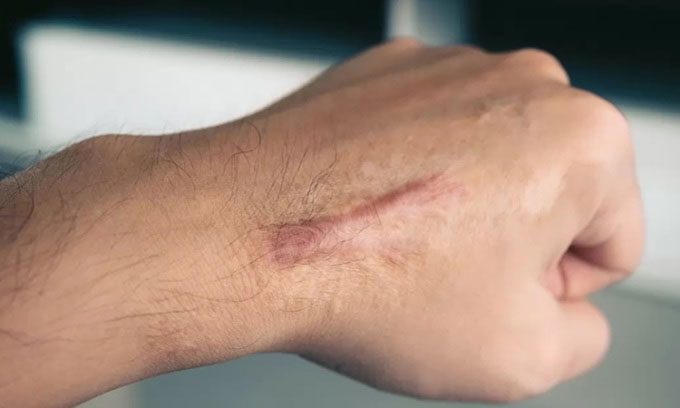Scar tissue has a different structure compared to normal skin, which is why it never completely disappears.
Scars come in various shapes, sizes, and colors, resulting from the skin’s natural healing process after injury, whether from surgery, infection, trauma, or rapid growth, according to Live Science. Scars play an important role by allowing the body to replace lost or damaged tissue.

Scarred skin differs significantly from surrounding skin. (Photo: Athletico)
The skin consists of three main layers. The outermost layer, known as the epidermis, is the thinnest layer, made up of several layers of flat cells called epithelial cells, forming a protective barrier against external influences. Beneath the epidermis lies the dermis, a large network of fibers made up of collagen and elastin proteins, which support the skin’s structure and elasticity. Finally, the hypodermis is the deepest layer, containing fatty tissue used for insulating the body and protecting tissues from damage.
If you only experience damage to the epidermis, as is common with sunburn, this outer layer will peel away, revealing the intact layers of skin underneath. However, if the damage extends deep into the hypodermis, the body will then heal the destroyed tissue. A layer of scab forms to seal the wound, followed by an inflammatory response that stimulates the healing process. Subsequently, the skin begins to restore tissue within the wound and creates a scar in the process.
In normal skin, the collagen fiber network of the dermis looks like a carefully woven piece of fabric with a smooth pattern, according to Dr. Damon Cooney, an associate professor of plastic and reconstructive surgery at Johns Hopkins Medicine. If an injury tears this “fabric,” the body will produce new collagen fibers to fill any gaps. However, instead of weaving these new fibers together to cover the wound, the body piles them up in a chaotic manner. This disorganized accumulation of collagen forms the bulk of scar tissue, making it appear very different and less flexible than normal skin.
Scar tissue also differs from healthy skin in that it contains no hair follicles or sweat glands. In light-skinned individuals, scars initially appear pink or red, but over time, this color fades, and the scar may become lighter or darker than normal skin. Scars on darker-skinned individuals often resemble dark spots.
Sometimes, the body continues to accumulate collagen within scar tissue longer than usual, resulting in keloid scars or hypertrophic scars. These are thick, raised scars that can be red, pink, or purple, or darker than the surrounding skin. Keloid scars are larger than the original wound, while hypertrophic scars are the same size. Teenagers and pregnant women are more likely to develop hypertrophic scars than other groups, possibly due to hormonal changes that enhance the inflammatory response in the body. Keloid scars are more common in people with darker skin tones, which may be influenced by genetic factors.
Scars can fade over time as the disorganized collagen fibers within begin to flatten and smooth out, according to Cooney. This process can take 6 to 18 months. The degree of scar fading depends on the size, location, and type of scar. However, scars never completely disappear because the disorganized fibrous tissue remains different from the surrounding skin.


















































